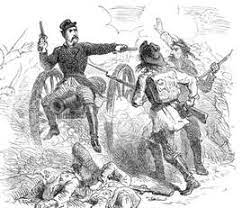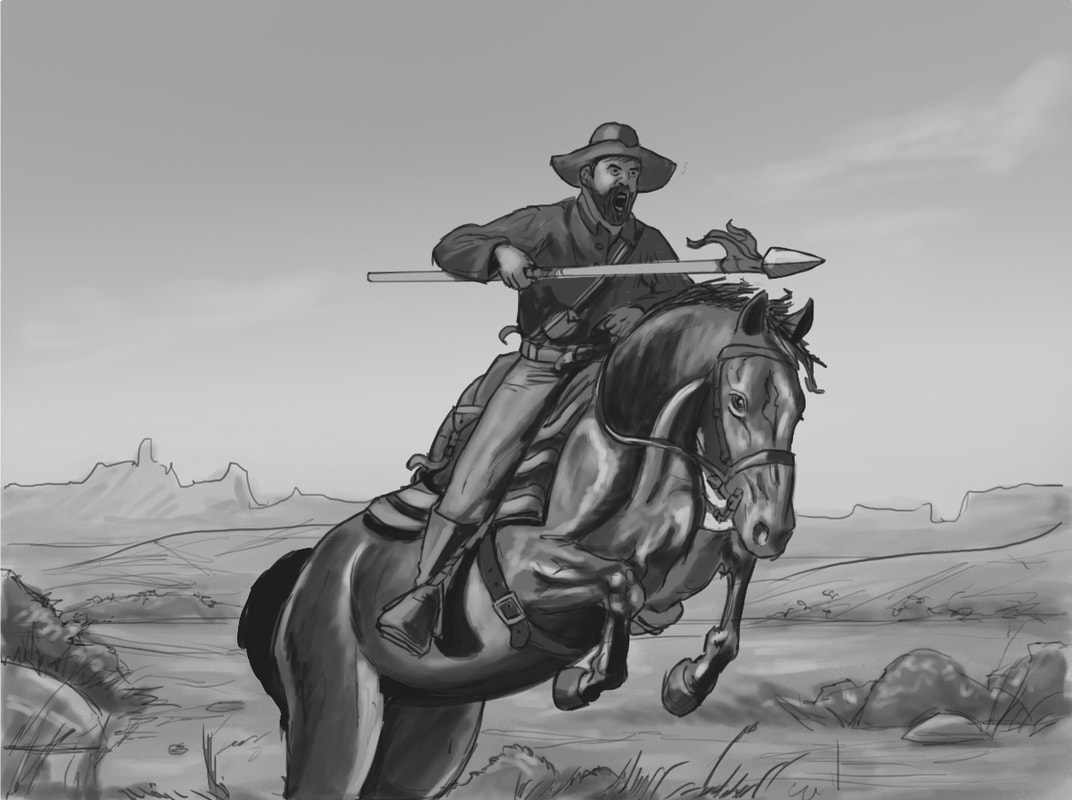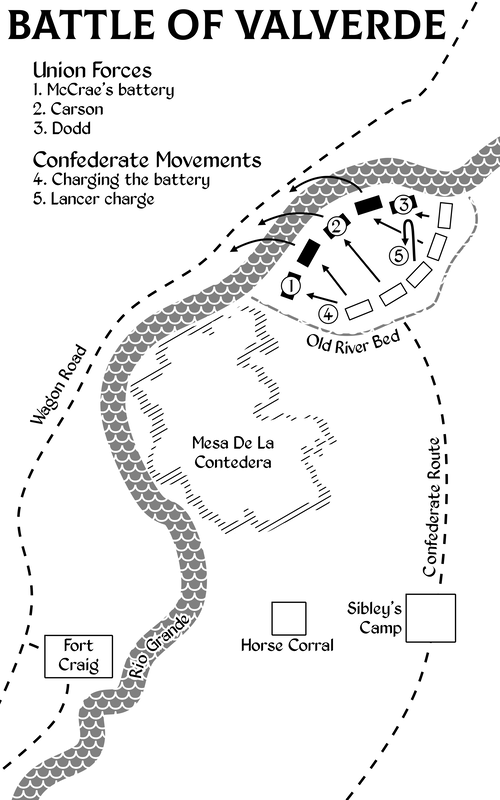
Not many people know about the Civil War Battle of Valverde these days. Most people assume that all the battles in the Civil War happened east of the Mississippi. Some might include Kansas. But there were battles out here in the Southwest, and one of the biggest and most important was the Battle of Valverde Ford, fought on February 21, 1862.
The Battle of Valverde, fought a few miles north of Fort Craig, along the Rio Grande in New Mexico Territory, was a victory for the Confederates, who were trying to fulfill a manifest destiny for the south that would stretch all the way to California. Like all battles, its story is made up of many smaller, poignant stories. One of the most dramatic is the taking of the Federal guns.
This etching, from a Harper’s Weekly that came out soon after the battle, shows a Union soldier perched atop of cannon while Confederate soldiers threaten him. It’s a fanciful and dramatic picture, and it fevered the minds of Northerners throughout the Union, but it’s factually untrue. The man depicted on the cannon is Captain Alexander McRae, and though he did not actually sit on his artillery piece, his story is compelling.
The Battle of Valverde, fought a few miles north of Fort Craig, along the Rio Grande in New Mexico Territory, was a victory for the Confederates, who were trying to fulfill a manifest destiny for the south that would stretch all the way to California. Like all battles, its story is made up of many smaller, poignant stories. One of the most dramatic is the taking of the Federal guns.
This etching, from a Harper’s Weekly that came out soon after the battle, shows a Union soldier perched atop of cannon while Confederate soldiers threaten him. It’s a fanciful and dramatic picture, and it fevered the minds of Northerners throughout the Union, but it’s factually untrue. The man depicted on the cannon is Captain Alexander McRae, and though he did not actually sit on his artillery piece, his story is compelling.

Alexander McRae was born in Fayetteville, North Carolina on September 4, 1829, and he was educated at the United States Military Academy at West Point. After graduating, he served in Missouri and Texas.. In 1856, he was posted to New Mexico in 1856. McRae spent some time at Bent's Fort, in what is now Colorado, then was moved south to Fort Union, Fort Stanton, and finally, Fort Craig. He steadily rose up the promotion ladder, becoming Captain of Company I, 3rd Cavalry Regiment in August of 1861.
When the Civil War broke out, McRae's father wrote to him, urging him to change sides. Captain McRae retained his commission and stayed faithful to his country. His four brothers, James, Thomas, John, and Robert, served the Confederacy.
As reports began to trickle into New Mexico of a Southern invasion, Colonel Edward R.S. Canby, the commander of forces in New Mexico Territory, hastily formed an artillery battery. He placed six pieces at Fort Craig, the most southerly of the forts held by the Union Army, and gave Captain McRae charge of this unit.
On the day of the battle, McRae's battery was dragged out of the fort and up toward the small town of Valverde, where a low spot in the Rio Grande created a natural crossing point which the Confederates wished to cross in their march north. McRae’s battery was placed on the western side of the river, and for the morning hours managed to keep the Confederates pinned down behind a sandy berm 800 hundred feet east of the river. During the afternoon, Colonel E.R.S. Canby, the commander of Union forces in New Mexico Territory, ordered the battery to cross the river. Soon after, the Confederates charged the guns.
When the Civil War broke out, McRae's father wrote to him, urging him to change sides. Captain McRae retained his commission and stayed faithful to his country. His four brothers, James, Thomas, John, and Robert, served the Confederacy.
As reports began to trickle into New Mexico of a Southern invasion, Colonel Edward R.S. Canby, the commander of forces in New Mexico Territory, hastily formed an artillery battery. He placed six pieces at Fort Craig, the most southerly of the forts held by the Union Army, and gave Captain McRae charge of this unit.
On the day of the battle, McRae's battery was dragged out of the fort and up toward the small town of Valverde, where a low spot in the Rio Grande created a natural crossing point which the Confederates wished to cross in their march north. McRae’s battery was placed on the western side of the river, and for the morning hours managed to keep the Confederates pinned down behind a sandy berm 800 hundred feet east of the river. During the afternoon, Colonel E.R.S. Canby, the commander of Union forces in New Mexico Territory, ordered the battery to cross the river. Soon after, the Confederates charged the guns.

One of the men leading the charge was Samuel A. Lockridge. Lockridge had been a Colonel in the private army of William Walker, an American physician, lawyer, journalist and mercenary, who was trying to establish an English-speaking colony in Nicaragua, but he and Walker had parted ways before Walker was defeated by a coalition of Central American armies and executed. He was also part of the Knights of the Golden Circle, a secret Southern society that advocated the extension of Southern institutions into new territory. When the Civil War broke out, Lockridge joined the Fifth Texas Cavalry, one of the divisions in Sibley’s Army of New Mexico. He was given the rank of Major.
At the Battle of Valverde, Lockridge led one of the in three separate waves that stormed the Union battery. Screaming the Rebel yell, the nearly 750 man force advanced on the guns. Athough they were armed with only short-range shotguns, pistols, muskets, and bowie knives, the Confederates had been told to dive to the ground whenever they saw a flash from the artillery. This strategy made them appear to be suffering a high casualty rate even though they avoided being hit. This spooked the men manning the Union guns, particularly the inexperienced and ill-trained New Mexico Volunteers. Both Volunteers and regular Army broke and splashed across the Rio Grande in a disorganized retreat.
Once the Texans reached the battery, fierce hand-to-hand fighting ensued among the remaining Union soldiers and the advancing Confederates. According to eyewitness accounts, Samuel Lockridge shouted, "Surrender McRae, we don't want to kill you!" McRae supposedly replied, "I shall never forsake my guns!" Soon after, McRae was shot. Some sources suggest that Lockridge himself shot him. Supposedly, Lockridge then laid his hand on the muzzle of one of the cannons and shouted “This one is mine!” He was shot dead soon after, perhaps by McRae.
The captured guns went to San Antonio when the Confederate forces retreated. They became known as the Valverde Battery and were used against Union troops for the remainder of the war.
At the Battle of Valverde, Lockridge led one of the in three separate waves that stormed the Union battery. Screaming the Rebel yell, the nearly 750 man force advanced on the guns. Athough they were armed with only short-range shotguns, pistols, muskets, and bowie knives, the Confederates had been told to dive to the ground whenever they saw a flash from the artillery. This strategy made them appear to be suffering a high casualty rate even though they avoided being hit. This spooked the men manning the Union guns, particularly the inexperienced and ill-trained New Mexico Volunteers. Both Volunteers and regular Army broke and splashed across the Rio Grande in a disorganized retreat.
Once the Texans reached the battery, fierce hand-to-hand fighting ensued among the remaining Union soldiers and the advancing Confederates. According to eyewitness accounts, Samuel Lockridge shouted, "Surrender McRae, we don't want to kill you!" McRae supposedly replied, "I shall never forsake my guns!" Soon after, McRae was shot. Some sources suggest that Lockridge himself shot him. Supposedly, Lockridge then laid his hand on the muzzle of one of the cannons and shouted “This one is mine!” He was shot dead soon after, perhaps by McRae.
The captured guns went to San Antonio when the Confederate forces retreated. They became known as the Valverde Battery and were used against Union troops for the remainder of the war.

Because he fought for the Union, McRae's service record went unrecognized in his home state. In their story on the battle at Valverde, the Fayetteville Observer did not even report his death. However, McRae became an honored figure in New Mexico history. There are streets named after him in the New Mexican towns of Las Cruces and Las Vegas, and a canyon named for him in Sierra County. The remains of Fort McRae, a late Civil War and Indian War Army post named for him, now lay beneath the waters of Elephant Butte Lake. I could find some earlier reports of it being a destination for scuba divers, but the adobe walls have probably succumbed to time and water by now.
Alexander McRae's body was exhumed in 1867 and transported to West Point for burial. McRae’s large black tombstone is only four markers away from the one dedicated to George Armstrong Custer. Guides frequently note it as the resting place of one who stayed with the Union.
Lockridge was buried on the battlefield. The whereabouts of the grave is unknown.
Alexander McRae's body was exhumed in 1867 and transported to West Point for burial. McRae’s large black tombstone is only four markers away from the one dedicated to George Armstrong Custer. Guides frequently note it as the resting place of one who stayed with the Union.
Lockridge was buried on the battlefield. The whereabouts of the grave is unknown.

The story of McRae and Lockridge meeting at the battery is told in Jennifer Bohnhoff's historical novel Where Duty Calls. This book is written for middle grade readers and will be published by Kinkajou Press, a division of Artemesia Publishing, in June 2022. It is available for preorder here.














